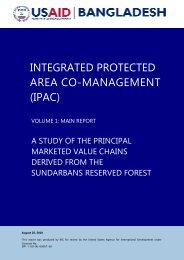Child Equity Atlas - BIDS
Child Equity Atlas - BIDS
Child Equity Atlas - BIDS
You also want an ePaper? Increase the reach of your titles
YUMPU automatically turns print PDFs into web optimized ePapers that Google loves.
<strong>Child</strong> <strong>Equity</strong> <strong>Atlas</strong><br />
Table 5.1: Proportion of households living<br />
in ‘pucca’ houses: Best and worst districts,<br />
Bangladesh 2011<br />
Srl.<br />
Best districts<br />
Worst districts<br />
District % District %<br />
1. Dhaka 45.6 Kurigram 0.9<br />
2. Chittagong 25.0 Netrakona, Sherpur 1.5<br />
3. Chuadanga 22.1 Lalmonirhat 1.6<br />
4. Sylhet 21.7 Bhola 1.7<br />
Barguna, Gaibandha,<br />
5. Narayanganj 20.7<br />
Jamalpur, Panchagarh<br />
Bangladesh: 11.3%<br />
2.0<br />
Table 5.2: Proportion of households living in<br />
‘kutcha 21 ’ houses: Best and worst districts,<br />
Bangladesh 2011<br />
Srl.<br />
Best districts<br />
Worst districts<br />
District % District %<br />
1. Dhaka 17.8 Barguna 93.2<br />
2. Gazipur 45.2 Kurigram 91.7<br />
3. Narayanganj 45.7 Patuakhali 91.6<br />
4. Meherpur 46.5<br />
Bandarban ,<br />
Sherpur<br />
91.1<br />
5. Sylhet 47.0 Khagrachhari 90.8<br />
Bangladesh: 69.1%<br />
5.2 Access to Sanitary Toilet<br />
5.2.1 It is important to note that the definition<br />
of a sanitary toilet in this <strong>Atlas</strong>, based on the<br />
Census, refers to toilets that are with water seal<br />
and those without water seal. The definition did<br />
not consider if the toilets were shared or not with<br />
other households or other details on the toilet<br />
types as in the JMP protocol. Like the condition<br />
of housing, household access to a sanitary toilet<br />
has improved tremendously in the last 10 years<br />
with the proportion of households having access<br />
to sanitary toilet increasing from 38.9 per cent in<br />
2001 to 63.6 per cent in 2011. However, disparities<br />
in access between rural and urban areas and<br />
among the administrative divisions are evident,<br />
revealing the pockets of deprived populations<br />
21<br />
‘Kutcha’ includes ‘jhupri’ structures as well which constitute<br />
only 2.9 per cent of all structures for the country as a whole.<br />
where poverty reduction programmes and<br />
interventions should be directed. The proportion<br />
of households without access to sanitary toilet is<br />
significantly higher in rural areas (41.8 per cent)<br />
than in the urban areas (18.3 per cent). Among<br />
the administrative divisions, lack of access to a<br />
sanitary toilet is less among the households in<br />
Barisal (25.7 per cent), Dhaka (29.4 per cent) and<br />
Chittagong (29.7 per cent) divisions and much<br />
higher in Rajshahi (43.6 per cent), Sylhet (50.7 per<br />
cent) and Rangpur (56.1 per cent) divisions (Figure<br />
5.2). The pattern and trend of the distribution of<br />
households without access to sanitary toilets<br />
by districts are presented in Maps 5.2, and 5.3,<br />
comparing 2001 with 2011, and by upazilas in<br />
Map 5.4. At the extremes are the five best and<br />
worst districts without access to sanitary toilets<br />
(Table 5.3).<br />
Figure 5.2: Proportion of households without<br />
access to sanitary toilet by administrative<br />
divisions and rural and urban areas,<br />
Bangladesh 2011<br />
% of households<br />
58.8<br />
60.0 Total Rural Urban<br />
56.1 55. 7<br />
50.7<br />
47.0<br />
43.6<br />
37.4<br />
39.5<br />
41.8<br />
40.0<br />
33. 4<br />
36.5<br />
37.0 36.4<br />
27.3 29.7 29.4<br />
27.22<br />
25.7<br />
22.1<br />
23.4<br />
17.5<br />
118.3<br />
18.3<br />
20.0<br />
12.6<br />
0.0<br />
Barisal<br />
Dhaka<br />
Khulna hl<br />
Table 5.3: Proportion of households without<br />
access to sanitary toilet: Best and worst<br />
districts, Bangladesh 2011<br />
Srl.<br />
Best districts<br />
Rajshahi<br />
Rangpur<br />
Sylhet<br />
Total<br />
Worst districts<br />
District % District %<br />
1. Dhaka 6.5 Bandarban 73.4<br />
2. Jhalokati 13.3 Thakurgaon 72.3<br />
3. Gopalganj 14.6 Gaibandha 69.5<br />
4. Barisal 17.5 Sunamganj 67.3<br />
5. Shariatpur 18.0 Nilphamari 67.0<br />
Bangladesh: 36.4%<br />
66














